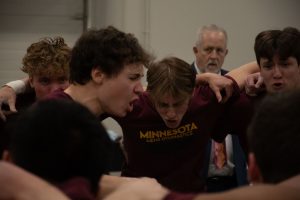Humphrey Institute of Public Affairs professor John Brandl told a House committee Monday the Legislature could protect students from higher education price increases with a budget solution similar to one he proposed in 1983.
Brandl, who chaired the Higher Education Finance Committee at the time, was the chief author of the legislation designing the state’s current higher education grants program.
The solution the Legislature adopted in 1983, Brandl said, withheld some funding from higher education and devoted that money to grants to protect low- and middle-income students from tuition hikes.
“The desire of the state, the policy of the state, is to see to it that people get educated, not that they get educated in particular institutions,” Brandl said.
Cutting $30 million from higher education, Brandl said, would result in a 10 percent tuition increase, which the state could offset by devoting $15 million to grants. This plan, he told the committee, would save the state $15 million.
“None of the things you have before you for the next biennium are easy or fun,” Brandl told the legislators.
Brandl said the plan could work with any dollar amount. A $20 million cut to higher education, he said, could be recouped with a 7 percent tuition increase. The state could cover the cost of that increase with an additional $10 million in the grants program, saving the state $10 million.
Brandl said this approach, which he called “aiding individuals rather than institutions,” would also stimulate competition among higher education institutions and promote student choice among schools.
Brandl also said the state’s focus should be on providing financial aid for students who most need it rather than subsidizing all students by giving more money to institutions.
In response to questions, however, he also noted that public support for higher education institutions lowers costs for students.
Focus shifting to grants
The committee also heard testimony from legislative analyst Kathy Novak on the status of state and federal higher education aid programs for Minnesota students.
Novak said public and private undergraduate enrollment increased 8 percent in the state during the last 10 years, while tuition and fees at public institutions rose 54 percent and financial aid allocations doubled.
“The mix of grants and loans has shifted slightly but not significantly over this time period,” she said.
Loans make up approximately 52 percent of Minnesota students’ financial aid. Grants comprise 45 percent, and work-study programs account for 3 percent.
Novak said Minnesota’s financial aid programs depend on the Legislature allocating money for them.
“Under Minnesota law, none of the programs are entitlements,” she said. “They are all available on a funds-available basis.”
Child care aid for students is particularly dependent on legislative allocations, Novak said, and funding for that program has dropped from $4.7 million to just more than $1 million in fiscal year 2003 because the Legislature transferred the remaining funds to the grants program.
The Legislature also diverted work-study funding for the fiscal year to the grants budget.
Overall, Novak said, “Minnesota has one of the most well-funded need-based grant programs in the U.S.”
Andrew Pritchard covers politics and
welcomes comments at [email protected]













